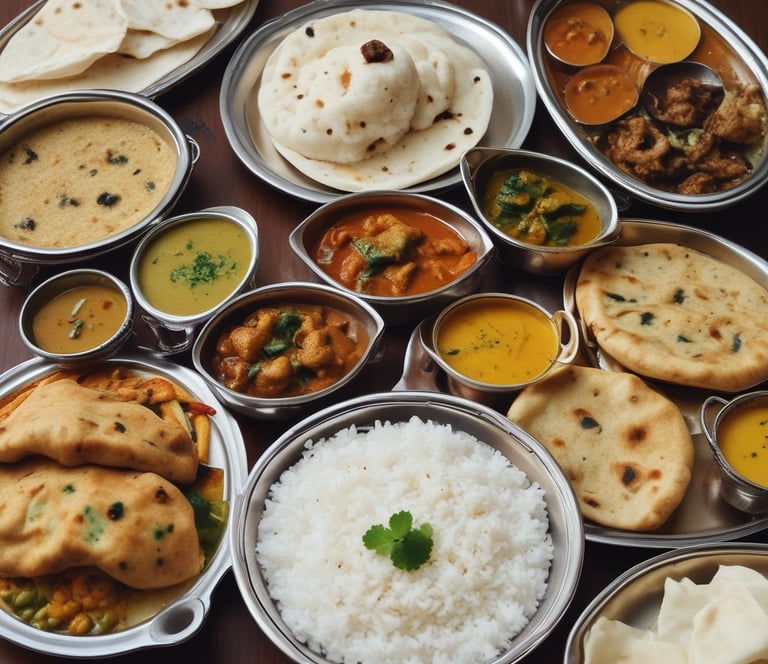Introduction to Indian Cuisine | Indian Food Guide
"Discover the rich flavors and traditions of Indian cuisine. Learn about Indian spices, popular cooking styles, and must-try Indian dishes in this comprehensive guide to traditional Indian food."
INDIAN CUISINE
4/16/20253 min read


Introduction to Indian Cuisine: Spices, Stories, and Signature Dishes
India's culinary traditions are as rich and varied as its culture, drawing on a history of thousands of years. With an abundance of spices, cooking methods, and regional flavors, Indian cuisine stands out as one of the most diverse and beloved around the world. If you’re new to Indian cooking or simply curious about what makes it so special, this guide will take you through the essentials of what makes Indian cuisine unique.
What Makes Indian Cuisine Unique?
Indian cuisine is renowned for its use of spices and herbs that not only create intense flavors but also add health benefits. It’s not just about flavor; it's about balance. Traditional Indian meals are composed to balance the six primary tastes—sweet, sour, salty, bitter, pungent, and astringent—which together create an extraordinary harmony of flavors. Spices such as turmeric, cumin, coriander, and garam masala dominate the Indian kitchen, each bringing a unique taste and aroma to the dishes they enhance.
India's culinary history is as old as its culture. Over the centuries, various invaders, settlers, and traders from Persia, Central Asia, and Europe have contributed their influences to the Indian food landscape, creating a fascinating fusion of flavors and techniques. This fusion, combined with the diverse geography and climate of India, means that each region has its own unique style of cooking.
The Role of Spices in Indian Cooking
The heart of Indian cuisine lies in its spices. Whether it's a simple dal (lentil soup) or a complex biryani, the flavors are always layered and intense. Some of the most commonly used spices include:
Turmeric: Known for its golden color and earthy flavor, it is often used in curries and rice dishes.
Cumin: Adds a warm, nutty flavor and is commonly used in almost every Indian dish.
Coriander: A bright, citrusy spice that is used both in its fresh form (as cilantro) and ground.
Mustard seeds: These tiny seeds are often used for tempering, adding a sharp, tangy flavor when fried in oil.
Indian cooking also uses chilies to add heat, but what sets Indian cuisine apart is the use of yogurt, tamarind, and coconut milk to balance the heat and create more complex flavors.
Popular Regional Cuisines in India
India’s diverse geography has given rise to many distinct regional cuisines. Some of the most notable include:
North Indian Cuisine: Famous for its rich gravies, curries, and roti, the north is home to dishes like butter chicken, dal makhani, and biryani. The influence of Mughal cuisine is still evident in the food here, with an emphasis on spices like cardamom, cinnamon, and saffron.
South Indian Cuisine: Known for its lighter, rice-based dishes like dosa, idli, and sambar. The southern states rely heavily on coconut, curry leaves, and mustard seeds for flavor.
West Indian Cuisine: Gujarat, Maharashtra, and Goa each have distinct food cultures. In Gujarat, dhokla and khandvi are popular, while Goan cuisine offers rich seafood dishes like prawn curry.
East Indian Cuisine: Known for its use of mustard oil and fish, eastern India offers dishes like machher jhol (fish curry) and momos (dumplings).
Top 5 Traditional Indian Dishes You Must Try
Indian cuisine is home to some truly legendary dishes. If you’re a beginner, here are five traditional dishes to get started with:
Butter Chicken
A rich, creamy curry made with marinated chicken cooked in a spiced tomato gravy. A quintessential North Indian dish that is enjoyed worldwide.Biryani
A fragrant rice dish made with spices, basmati rice, and either chicken, mutton, or vegetables. The complex flavors and aroma make it a must-try.Dosa
A crispy, thin pancake made from fermented rice and lentil batter. Typically served with chutneys and sambar, it's a breakfast favorite in South India.Samosa
A popular snack, these deep-fried pockets are filled with spiced potatoes, peas, and sometimes meat. They are a great introduction to Indian street food.Chana Masala
A vegetarian delight, this hearty dish is made from chickpeas simmered in a spicy, tangy sauce. It’s flavorful, healthy, and satisfying.
👉 Explore More: 15+ Authentic Indian Recipes in One Guide
Looking to take your Indian cooking skills to the next level? Our comprehensive digital recipe guide features over 15 authentic Indian dishes, from comforting curries to vibrant street food. Each recipe is carefully curated, complete with step-by-step instructions, tips, and tricks for bringing the rich, bold flavors of India right to your kitchen. Don’t miss out on this must-have resource for anyone passionate about cooking traditional Indian food. [Discover the Recipe Guide]
Final Thoughts: Bringing Indian Flavors to Your Kitchen
Indian cuisine is an exciting world of flavors, textures, and aromas. With so many regional varieties and an endless array of spices, there’s always something new to discover. Whether you’re a novice cook or an experienced foodie, exploring Indian cuisine can be an enriching experience that brings warmth and depth to your meals.
So, why not give it a try? Start with these essential dishes, and if you’re ready for more, dive deeper with our recipe guide featuring 15+ Indian classics. Your culinary adventure awaits!
Explore
Connect
© 2025. All rights reserved.
